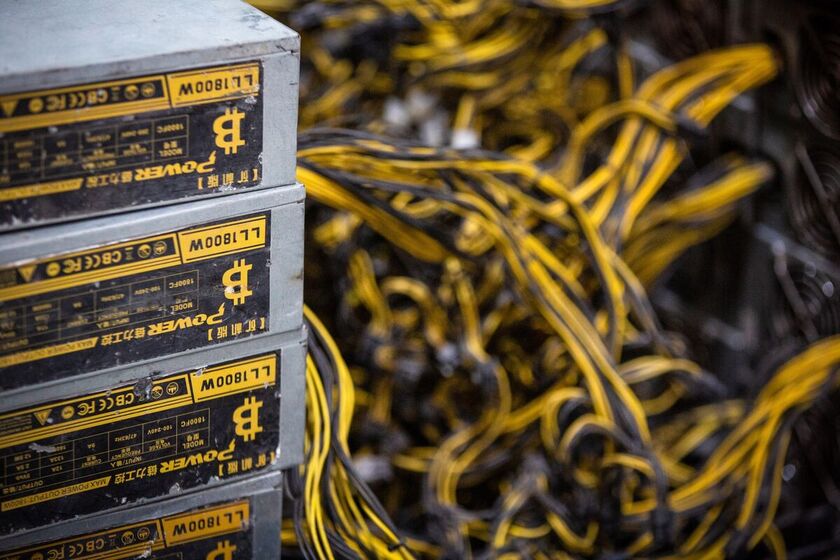For enthusiasts of Bitcoin, a once-every-four-years software update called the “halving” has long been held as one of the keys to propping up its value.
This time around, it’s also set to trigger multibillion-dollar declines in revenue for the very companies that ensure the digital currency’s smooth functioning, right on the heels of a surge in their biggest costs.
Around April 20, the halving will cut the amount of Bitcoin that “miners” can earn each day for validating transactions to 450 from 900 now. Based on Bitcoin’s current price, it could spell revenue losses of around $10 billion a year for the industry as a whole. Marathon Digital Holdings Inc., CleanSpark Inc. and other miners, which compete for a fixed Bitcoin reward by solving mathematical puzzles using superfast computers, have invested in new equipment and sought to buy smaller rivals in an attempt to cushion the drop-off in revenue.
“This is the final push for miners to squeeze out as much revenue as they can before their production takes a big hit,” said Matthew Kimmell, a digital asset analyst at CoinShares. “With revenues across the board decreasing overnight, the strategic response of each miner, and how they adapt, could well determine who comes out ahead and who gets left behind.”

Granted, Bitcoin has reached new highs after previous halvings, helping to mitigate the periodic drop in mining rewards and the increase in the cost of doing business. The event this month is coming after the digital currency has more than quadrupled since November 2022. Yet the margin of success for the industry keeps getting finer. Miners will need to continually spend more money in a never-ending, technological arms race for smaller rewards. And while the energy-intensive validation process has always made mining expensive, companies now face even more competition for power from the burgeoning and deep-pocketed artificial intelligence industry.
The soaring price of Bitcoin has helped offset those power costs and fueled growth in crypto mining. Since the first specialized machines came into play in 2013, the aggregate market cap of 14 U.S.-listed miners has grown to about $20 billion, according to an April 1 report by JPMorgan Chase & Co.
While US-listed miners are the face of the industry, they account for just about 20% of the sector’s computing power, according to crypto researcher TheMinerMag. Private miners make up the rest and could be more vulnerable after the halving as they typically must tap debt financing or venture capital to cover their needs, whereas public companies can raise funds via share sales.
As the hoopla has revved up around the event, some traders are betting that mining stocks will fall. Total short interest, the dollar value of the shares borrowed and sold by bearish traders, stood at about $2 billion as of April 11, according to an estimate from S3 Partners LLC. That short interest accounted for almost 15% of the group’s outstanding shares — three times more than the US average of 4.75%, said Ihor Dusaniwsky, managing director of predictive analytics at S3.
Bearish Bets
The total short interest in 15 crypto-mining stocks is nearly $2 billion
Source: S3 Partners LLC
Note: As of the close April 8, 2024
The update, the fourth since 2012, was preprogrammed by the anonymous Bitcoin creator Satoshi Nakamoto to maintain the hard cap of 21 million tokens to keep it from becoming inflationary as a currency.
The situation differs from four years ago when Bitcoin was trading under $9,000 and most of the mining activity took place in China. Since then, much of that activity has shifted to the US, driving competition for electricity.
“Power in the US is extraordinarily constrained,” said Adam Sullivan, chief executive officer at Austin, Texas-based Core Scientific Inc., one of the largest public Bitcoin mining companies. “Right now, miners are competing against some of the largest tech companies in the world, who are trying to find space for data centers, which are high energy consumers too.”
The nascent AI industry is drawing in massive amounts of capital, which is making it harder for miners to secure favorable electricity rates with utility companies. Amazon.com Inc. is set to spend almost $150 billion on data centers, while Blackstone is building a $25 billion empire of centers. Google Inc. and Microsoft Corp. are also making hefty investments.
Power Grab
“The artificial intelligence crowd is willing to pay three or four times what Bitcoin miners were paying last year” for electricity, said David Foley, co-managing partner at Bitcoin Opportunity Fund, which has made investments in both public and private miners. That is happening across the globe, he said.
The tech giants also have an edge in acquiring power from utilities, given their consistent revenue stream, whereas crypto mining revenue fluctuates with the rise and fall in Bitcoin prices. Utilities consider tech companies as more reliable purchasers given their strong balance sheets, said Taras Kulyk, CEO at crypto-mining services provider SunnyDigital.
With that competition in place, low-cost power contracts could be tougher to renew when existing agreements expire. Large-scale Bitcoin miners tend to lock in energy prices, typically for a few years, said Greg Beard, CEO of public Bitcoin miner Stronghold Digital Mining Inc.
Computer Power
Miners compete for a fixed amount of reward, with winner-take-all for the first to successfully process a block of transactions on the Bitcoin blockchain. That reward will drop to 3.125 Bitcoin at the halving from 6.25 now.
The more computing power a miner has, the more likely it is to earn the reward. But it’s getting harder. Mining difficulty, a measure of computing power to mine Bitcoin, has swelled almost sixfold since the 2020 halving, according to a biweekly update from crypto-mining website btc.com. That is a result of an increasing number of miners and a reward that remains fixed.
Companies have been updating their technology with more efficient machines to generate extra computing power, and public Bitcoin miners have raised billions of dollars to fund the purchases by offering new shares.
That option isn’t available to private mining businesses, which account for about 80% of the industry’s computing power in the US. During the previous bull run in 2021, those companies mostly relied on issuing debt to help cover their costs. Both public and private miners were estimated to have borrowed as much as $4 billion in loans backed by mining equipment around that time. But deals have been harder to come by as a slew of lenders went bankrupt during the crypto market crash in 2022.
“It is tough out there,” said Young Cho, CEO at Blockhouse Digital, an asset management firm that specializes in collateralized lending and yield-generating strategies in the crypto markets. “Miners have been looking for lenders for several months and they have not been able to find any.”
Besides debt financing, some private miners are raising money through venture capital funding rounds, Bitcoin Opportunity Fund’s Foley said.
Those with negative cash flows that don’t have access to borrowing are faced with the decision to finance operations through private equity or the cash preemptively stowed on their balance sheet, said Kimmell at CoinShares.
“Alternatively, if they have low confidence in future mining revenues, they may wind up exiting the market,” he said.





























